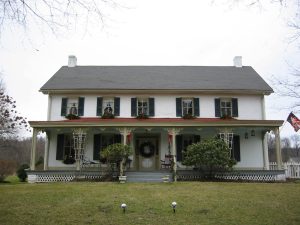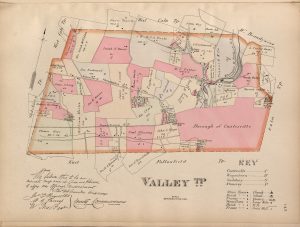Hunt Up Your Historic House History
You may learn something interesting
 The Hope-Handys had always wondered about the history of their farmhouse. The farm where the house was located had been in their family for 262 years, but they weren’t sure about its origins. Plus they were curious about an odd stone-walled interior room in the basement.
The Hope-Handys had always wondered about the history of their farmhouse. The farm where the house was located had been in their family for 262 years, but they weren’t sure about its origins. Plus they were curious about an odd stone-walled interior room in the basement.
To learn more, they wanted professional help. So they hired me, an architectural historian. Here’s a short version of the steps of our research, major discoveries and tips on how to hunt up the history of your home.
Researching the Hope-Handys’ Home
The first step in the investigation was to conduct a deed search. From that, we determined the farm was established by Robert Hope in 1760 on a 115-acre tract of land that had been assigned in 1742 to a “Widow Connor” by the Penn family’s land agents (yes, the William Penn family). The property was eventually sold to the Hope family in 1789.

Next, we reviewed the tax assessment records. While the deeds gave us an idea of when the farm was established, the tax records showed that by 1796, there were two stone houses on the property (now there’s only one).
Then on to the Chester County History Center to look through newspaper clippings files, photo-archives, postcard collections and township histories, as well as the federal and state agricultural and population census records for more information about the farm and its occupants. In addition, the Hope-Handys had family papers and ephemera that proved to be very helpful.
After the research, we concluded that Robert Hope constructed the first house, barn and springhouse on the farm in 1760. This first house was stone, while the barn and the springhouse were built of logs.

In 1787, another small stone house was built and expanded with a stone wing in 1820. Meanwhile, the 1760 house was used solely as a kitchen. Then in 1835, the 1760 house was demolished, and the 1787 house was reduced to its foundation and the first story of its south wall. In its place a stone ell was added, which became the new core of the house.
These events explained the presence of that odd interior room located in the front center of the Hope-Handys’ basement: it was the remains of the 1787 stone house.
The Hope-Handys now knew the history of their home and solved the mystery of the underground room.
Researching Your Home
If you’re interested in hunting down the history of your house, the steps are similar. Here are some tips for your project, tailored to resources available in Chester County.*

You’ll need two important things for your research. First: patience. You’ll find all kinds of interesting and exciting information along the way. But be forewarned: the beginning of your search — known as a deed search — may seem tedious. Invariably, you’ll hit dry spells when you’ll find nothing or nothing exciting. Don’t despair. Keep going, and the end result will more than make up for early frustration.
The second thing you’ll need are appropriate supplies: #2 pencils (never use ink pens or markers) and paper for notes. To stay organized, use a legal pad, spiral notebook, index cards in a box or a laptop.
With your supplies in hand, you’re ready to start the hunt!
STEP ONE. You’ll need to find the following information from your tax bill: 1) the municipality where your property is located, 2) the property’s street address and 3) the names of all the current owners.
STEP TWO. Next go to the Chester County Tax Assessment Office, where you’ll ask the clerk for help with three things: 1) how to find the tax parcel number for your property, 2) how to get the following information: the owners’ names as they appear on the deed; the acreage and accessories; and the deed reference, including the Deed Book and Page, and the deed date (sometimes the date is missing buy don’t worry), and 3) a copy of that portion of the relevant tax parcel map that’s centered on your property. You may also need help figuring out the tax parcel map number.
STEP THREE. There are two options here. Either conduct your deed search online — from your home or anywhere — or visit the Recorder of Deeds Office. If you opt for online research, go to the Recorder of Deed’s website (ChesCo.org/169/Recorder-of-Deeds) and follow the instructions for property searches, then follow the deed search procedures below. To make copies, pay online with a credit card.
For researching your deed in person at the Recorder of Deeds Office, use the deed reference information you found at the Assessment Office and ask the Deeds Office clerk to explain how to use that office’s computers for your search.
Once you’ve found the deed on the computer, make a copy rather than trying to read the deed in-depth on the screen. If you make a copy, you’ll have the deed to refer back to.
Tip: For in-person research, take plenty of quarters and cash for copying.
Make sure you have the following information in each deed copy: 1) date of indenture (settlement), 2) grantor (seller) and grantee (buyer) names, 3) location, 4) metes and bounds, 5) acreage, 6) deed referral and 7) date of record. These items are listed in the order they usually appear in the deeds (Note: Not all deeds contain all this information).
Check each deed to make sure you have as much of this information as is available. Then check the deed referral clause in that deed to get to the next deed you’ll need.
Go back to the beginning of step three, and repeat until you run out of deeds.
Whichever option you choose for your deed search, you may find a deed book reference that’s not online. If you’re at the Deeds Office, ask the clerk for help. If the missing deed is earlier than 1924, you’ll have to visit the Chester County Archives.
Your deed referral clause may lead you to a will or administration papers. These papers are filed in the Registrar of Wills Office, which has wills and administration papers probated from 1924 to the present only. Those probated before 1924 are at the Chester County Archives.
STEP FOUR. Frankly, this step and the next can be the most fun and rewarding in your hunt. In step four, you explore other primary sources such as tax assessment records, road papers and tavern petitions found at the Chester County Archives.
Ask the archivist if there are any other primary and secondary sources available that might prove useful or interesting.
STEP FIVE. Take all the research you’ve gathered and go to the Chester County History Center Library. The History Center Library has, among other records, an extensive collection of newspaper clippings, old photographs and postcards, land records, maps and atlases, plus genealogy and township books.
Again, ask the librarian if there are other primary and secondary sources available that might prove helpful or interesting.
Tip: Before you set out on your hunt, call the Tax Assessment and Recorder of Deeds Offices, as well as the Archives and History Center to find out when they’re open, whether there are entrance fees and photocopying charges. Also, at the start of your first visit to the offices or repositories, ask the staff to familiarize you with their facility.
If you run into a dead end, ask the clerks, archivists or librarians for help. They’re there to help, and many are experienced researchers themselves. Just remember, their duties go beyond helping researchers — especially courthouse clerks. So, be patient.
You may learn some fascinating history of your home or of its previous owners buried away in the most unlikely places. Happy hunting!
*Note: Each county organizes its records in its own way. Before you start your research, call your county courthouse to find out where tax assessment maps, deeds, wills and administration papers are stored for public access. The same advice goes for your county historical society and archives.
Helpful Addresses and Phone Numbers
Chester County Tax Assessment Office, 313 W. Market St., Ste 4202, West Chester, 610-344-6105
Chester County Recorder of Deeds Office, 313 W. Market St., Ste 4302, West Chester, 610-344-6330
Chester County Register of Wills Office, 201 W. Market St., Ste 2200, West Chester, 610-344-6335
Chester County Archives, Govt. Services Center, 610 Westtown Rd., Ste 080, West Chester, 610-344-6760
Chester County History Center, 225 N. High St., West Chester, 610-692-4800
 Jane E. Dorchester is an architectural and local historian, historic preservationist, lecturer, researcher and writer who started in the preservation field in 1983. She’s researched the histories of many properties, including taverns, industrial properties and schools, conducted historic resource inventories and surveys, written historic impact studies, National Register nominations and more. In 2001, Jane earned her master’s degree in Historic Preservation from the University of Pennsylvania. She provides historic preservation consulting services based in East Goshen Township.
Jane E. Dorchester is an architectural and local historian, historic preservationist, lecturer, researcher and writer who started in the preservation field in 1983. She’s researched the histories of many properties, including taverns, industrial properties and schools, conducted historic resource inventories and surveys, written historic impact studies, National Register nominations and more. In 2001, Jane earned her master’s degree in Historic Preservation from the University of Pennsylvania. She provides historic preservation consulting services based in East Goshen Township.
Our Favorite Resources
- Ball & Ball
- Berk Hathaway Country Properties
- Berk Hathaway Holly Gross
- Berk Hathaway M. Schwartz
- Canvas Valley Forge
- Closet Factory
- Dewson Construction
- DiSabatino Landscaping
- Homestead Structures
- King Construction
- Main Street Cabinet
- McComsey Builders
- Monument/Sotheby’s Int’l
- Mostardi Nursery
- Renewal Dynamics
- Sheller Energy
- White Horse Construction
